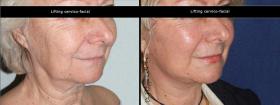Face and neck cosmetic surgery Cervical face or mid-facelift and temporary lifts
What is the most appropriate lift for you ?
Today the lift has to be "custom tailored". Different types of Facelifts enable to treat the face and neck :
- Cervical facelift processes the middle and lower parts of the face (the neck, falling cheeks and jowls, bitterness folds and nasolabial furrows).
- Temporary facelift operates on the temples and the eyelids external angle.
- Mid-facelift allows a targeted treatment on the eyelids, cheeks, nasolabial furrows and jowls with small incisions in the lower eyelids.
What are the motivations for a facelift ?
Our face carries with itself the passing years, the signs of aging, with skin sagging ... but it also bears our emotions and a part of our personality.
This is why surgeons use different techniques to achieve a facial rejuvenation and not a transformation, for a natural result.
This rejuvenation operation is aimed for women and men who wish to correct signs of aging.
What are the objectives of cosmetic surgery ?
The Facelift can be done on the entire face and neck.
The surgeon operates on a face marked by aging to rejuvenate it, making it look relaxed, rested while maintaining its natural.
Importance of 1st consultation
As with any cosmetic surgery, the facelift involves risks to know, pre-operative examinations to practice and protocols to follow.
During your first consultation, you get a professional answer to all your questions , your concerns and your surgeon offers you the adapted lift for your face.
There is no specific age since nobody gets old in the same way, but it is uncommon to consider a lift before the age of 40 years.
No medication containing aspirin should be taken 10 days before surgery. Tobacco is imperative to stop one month before surgery.
What happens during the surgery ?
The surgeon operates on the skin surface, on the muscles and on the fat if necessary.
He is first going to correct the sagging muscles and to redrape the skin as you have agreed together, but not too much to keep your face natural.
Solidifying your muscles allows maintaining the final result, a rejuvenated face, over time.
If there is an excess of fat, liposuction can correct it. On the contrary, if you find your face too thin, liposculpture can be considered. After surgery a dressing is placed around the face, it will generally be removed the next day.
+ What is the type of anesthesia ?
According to the case, anesthesia may be local, deep if administered intravenously by tranquilizers or general.
This will be the subject of a discussion between you and your surgeon during a consultation.
+ And the scar ?
As the incisions are hidden in the folds of the skin or in the hair, the scar is very discreet and almost completely hidden.
+ How long is the surgery ?
It varies between 2 and 3 hours.
What are the postoperative courses ?
Hospitalization usually lasts one day.
The tightness is reduced with analgesics.
Bruising (bruises) and an edema (swelling) appear on the treated area, but gradually disappear.
Rest is recommended as much as possible. Avoid effort.
You must wait 2 to 3 weeks before meeting up with persons you don’t want to know about the operation.
What are the possible complications ?
Following any operation whatsoever , certain complications can occur, the first ones related to the medical activity and the others to anesthesia.
Although possible complications only represent a small percentage, it is necessary to know them.
+ What are the specific risks of the surgery ?
During the consultations with your surgeon all the possible complications will be detailed to you . Fortunately the real complications are quite unusual.
- To inform you in advance, here are the possible risks:
- An hematoma : requiring prompt evacuation.
- A localized skin necrosis responsible for delayed healing.
- An infection : which may require antibiotic treatment.
These informations given by Dr. Philippe Letertre should only be a help or a supplement to your surgeon’s consultations
Our space "Questions / Answers" is also available for you.
Feel free to contact Dr. Letertre
so that he could meet your expectations.


